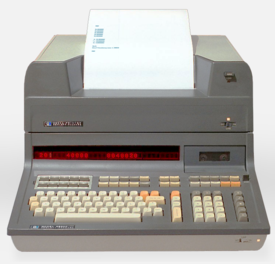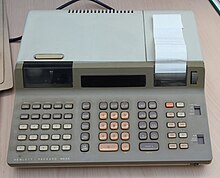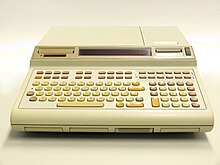An ancestor of modern personal computers
The HP 9800 series were developed by HP's Loveland division (Calculator Products Division), and later Fort Collins division (Desktop Computer Division). Early desktop computers were marketed as "Calculators" to make purchasing easier. At the time, some companies had different procedures for purchasing "Computers".
They spawned development of the HP Series 80 machines, including the HP 85 and HP 87, which were smaller BASIC language computers with CRT displays. They came from HP's Advanced Products Division based in Corvallis.
For a short time in the late 1970s and early 1980s there was a class of similar desktop computers, such as the Tektronix 4051, IBM 5100 and Wang 2200 - before they were replaced in the marketplace by personal computers such as the Apple and IBM PC.
HP 9830
HP 9830 uses
HP 9830s were commonly employed at aerospace companies such as Boeing. They were also used by some school systems such as Arlington, Virginia, and Renton, Washington, which used pencil mark-sense cards with card readers to accommodate classroom use. An HP 9830 system with an integrated hard drive was also provided by HP in the early 1970s to National Real Estate Exchange, Inc., a small company in Florida, for its use in developing early real estate software. The U.S. Coast Guard devised a teletype message-forwarding system based on 9825As which were deployed as a working prototype for a subsequent purpose-built system, and also used them in the coordination of LORAN radionavigation transmitter chains. HP9825s were used in conjunction with Oscor software to score one-design yachting regattas in remote locations, such as the 1976 World Fireball championships in Nova Scotia, the World Windsurfing championships in 1976/1977 in Cancún and Bahamas, and also Laser championships. The HP9825 was selected because it was portable – the only alternatives were phone access to time sharing computers which was not reliable from these locations.
HP 9830 description
9830s were built with a processor similar in architecture to the HP 1000/2100 series minicomputer with 16-bit memory address, and an AX and BX general processor register. They ran at a speed comparable to the first IBM PCs. They could draw a mesh of a 3D SIN(X)/X function with no hidden lines over the course of several minutes, a technological breakthrough for the time.
Because programs were designed to run from ROM (read only memory) the call subroutine instruction had to be changed because in the HP211x the return location was written in the first location of the subroutine. Instead, another register was created to keep track of return locations on a separate stack area, like more modern processors. [10] This made recursion possible.
Some models (e.g. 9835B) used a 32-character 1 line uppercase LED display, which on the one hand might seem limiting, but on the other hand had the same effect as one-line window into a full screen editor which did not become common until the 1980s, with controls to go up or down a line, and cursor left and right, inserting or deleting characters. They powered on ready to do math in "immediate mode", where you would type in an expression such as PRINT 2 + 3, and you would get an answer when you hit enter, without the complication of logging in, or the overhead of maintaining a big computer room and operator.
A computer controlled cassette drive using audio cassettes with clear leaders for optical detection of end of tape was used for storage. Random access to a file was by number, but a hard drive could also be attached.
The matching line thermal printer was quite fast, printing one horizontal line of dots at once. The speed of a page was faster than later dot matrix printers, and not much worse than modern ink jet printers. HP incorporated thermal printers into many plotting and terminal products later.
Programming
Although the processor used was only a slight adaptation from that used on HP minicomputers, the system software would be completely redesigned for a computer with its operating system and language system built into read-only memory. BASIC was similar to FORTRAN used by engineers on the HP 1000 minicomputer, but much simpler to use as an interpreted language. Arrow cursor keys were provided which could scroll up and down lines, and interactively insert or delete characters which was unheard of with most CRT or printing terminals until the advent of the screen editor in the late 1970s, and the programmer could single-step or check values of variables.
Two rows of user-defined function keys with paper labels were some of the earliest implementation of general function keys. They would be the basis for later screen labeled function keys used in later Hewlett Packard (and IBM) terminals and computers, and now widely adopted in calculators, bank terminals, and gas pumps.
It was programmable in BASIC, which could be extended with ROMs to do graphics plotting, matrix math and string variables. The ROM cartridges were designed to extend the BASIC language, and were very similar to the cartridges later used by video game consoles.
The Plotter ROM added commands which made creating a chart much more simple than is possible with C++ or C#, and used either user or world coordinates rather than integer plotter units. These commands would later become the basis for the device-independent HP AGL graphics language standard implemented on other HP computers such as the HP 1000 minicomputer and HP 2647 intelligent graphics terminal.
10REMARKDRAWAPARABOLA20SCALE-1.0,1.0,-1.0,1.030FORX=-1.0TO1.0STEP0.1040PLOTX,X*X50NEXTX60END
Also available for programming the HP 9800 series was a bootable development environment based on UCSD Pascal.
HPL Language description
In HPL instead of variables such as A1 and J2, there were numbered registers r1, r2, up to r199999.
The following HPL program for the HP 9825 generates a list of prime numbers:
0: fxd 0 1: prt 1 2: prt 2 3: 1→P 4: for C=2 to 1000000 5: P+2→P 6: for N=3 to P/3 7: if int(P/N)*N = P; gto 4 8: next N 9: prt P 10: next C
Another unique characteristic of HPL was the right arrow. This arrow was known as the gazinta (slang for "goes into"). The statement 1→P would be pronounced "One gazinta P".
Other BASIC computers
The Data Terminals Division also produced a BASIC programmable version of the HP2640 series terminal, the HP 2647a, which also featured AGL, an HP standardization of the HP 9830 plotter commands.
HP 2647 BASIC was essentially Microsoft BASIC with HP 9830-style plotting commands added, and was one of Microsoft's first big contracts with a mainstream computer company.
HP also produced a series of handheld pocket computers with a one-line display such as the HP-75, although such devices were not popular for long.
The HP 9835 was also used as the basis for a business computing system, and later the HP 250 which lives on as an application platform.
In 1979 the 85, the first machine in the HP Series 80 line of personal desktop scientific computers, was produced. It had a powerful BASIC interpreter, and was affordable by individuals whose employers might have expensive 9845s.
That division evolved to produce UNIX HP 9000 series workstations, also acquiring the Apollo Computer Company. HP Basic would later evolve into Rocky Mountain BASIC for workstations, which is still in use today to support legacy applications.

An electronic calculator is typically a portable electronic device used to perform calculations, ranging from basic arithmetic to complex mathematics.

The PDP–11 is a series of 16-bit minicomputers sold by Digital Equipment Corporation (DEC) from 1970 into the late 1990s, one of a set of products in the Programmed Data Processor (PDP) series. In total, around 600,000 PDP-11s of all models were sold, making it one of DEC's most successful product lines. The PDP-11 is considered by some experts to be the most popular minicomputer.

A microcomputer is a small, relatively inexpensive computer having a central processing unit (CPU) made out of a microprocessor. The computer also includes memory and input/output (I/O) circuitry together mounted on a printed circuit board (PCB). Microcomputers became popular in the 1970s and 1980s with the advent of increasingly powerful microprocessors. The predecessors to these computers, mainframes and minicomputers, were comparatively much larger and more expensive. Many microcomputers are also personal computers. An early use of the term "personal computer" in 1962 predates microprocessor-based designs. (See "Personal Computer: Computers at Companies" reference below). A "microcomputer" used as an embedded control system may have no human-readable input and output devices. "Personal computer" may be used generically or may denote an IBM PC compatible machine.

A desktop computer is a personal computer designed for regular use at a stationary location on or near a desk due to its size and power requirements. The most common configuration has a case that houses the power supply, motherboard, disk storage ; a keyboard and mouse for input; and a monitor, speakers, and, often, a printer for output. The case may be oriented horizontally or vertically and placed either underneath, beside, or on top of a desk.

The Commodore PET is a line of personal computers produced starting in 1977 by Commodore International. A single all-in-one case combines a MOS Technology 6502 microprocessor, Commodore BASIC in read-only memory, keyboard, monochrome monitor, and, in early models, a cassette deck.

Wang Laboratories was a US computer company founded in 1951 by An Wang and G. Y. Chu. The company was successively headquartered in Cambridge, Massachusetts (1954–1963), Tewksbury, Massachusetts (1963–1976), and finally in Lowell, Massachusetts (1976–1997). At its peak in the 1980s, Wang Laboratories had annual revenues of US$3 billion and employed over 33,000 people. It was one of the leading companies during the time of the Massachusetts Miracle.

A function key is a key on a computer or terminal keyboard that can be programmed to cause the operating system or an application program to perform certain actions, a form of soft key. On some keyboards/computers, function keys may have default actions, accessible on power-on.

The HP 2100 is a series of 16-bit minicomputers that were produced by Hewlett-Packard (HP) from the mid-1960s to early 1990s. Tens of thousands of machines in the series were sold over its twenty-five year lifetime, making HP the fourth largest minicomputer vendor during the 1970s.

The IBM 5100 Portable Computer is one of the first portable computers, introduced in September 1975, six years before the IBM Personal Computer, and eight before the first successful IBM compatible portable computer, the Compaq Portable. It was the evolution of a prototype called the SCAMP that was developed at the IBM Palo Alto Scientific Center in 1973. Whether considered evolutionary from SCAMP or revolutionary, it still needed to be plugged into an electric socket.
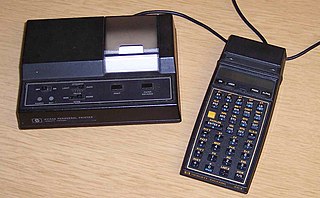
The HP-41C series are programmable, expandable, continuous memory handheld RPN calculators made by Hewlett-Packard from 1979 to 1990. The original model, HP-41C, was the first of its kind to offer alphanumeric display capabilities. Later came the HP-41CV and HP-41CX, offering more memory and functionality.
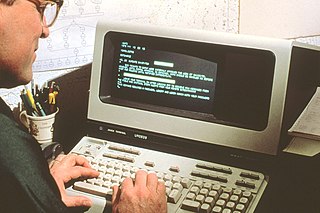
The HP 2640A and other HP 264X models were block-mode "smart" and intelligent ASCII standard serial terminals produced by Hewlett-Packard using the Intel 8008 and 8080 microprocessors.
HP BASIC may refer to any of several different BASIC dialects, of distinct lineages, created at either Hewlett-Packard (HP) or Digital Equipment Corporation (DEC).
Rocky Mountain BASIC is a dialect of the BASIC programming language created by Hewlett-Packard. It was especially popular for control of automatic test equipment using GPIB. It has several features which are or were unusual in BASIC dialects, such as event-driven operation, extensive external I/O support, complex number support, and matrix manipulation functions. Today, RMB is mainly used in environments where an investment in RMB software, hardware, or expertise already exists.
Programmable calculators are calculators that can automatically carry out a sequence of operations under control of a stored program. Most are Turing complete, and, as such, are theoretically general-purpose computers. However, their user interfaces and programming environments are specifically tailored to make performing small-scale numerical computations convenient, rather than general-purpose use.

The Hewlett-Packard Series 80 of small scientific desktop computers was introduced in 1980, beginning with the popular HP-85 targeted at engineering and control applications. They provided the capability of the HP 9800 series desktop computers with an integrated monitor in a smaller package including storage and printer, at half the price.
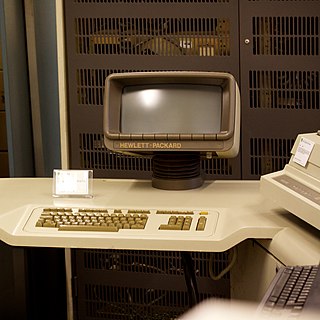
The HP 250 was a multiuser business computer by Hewlett-Packard running HP 250 BASIC language as its OS with access to HP's IMAGE database management. It was produced by the General Systems Division (GSD), but was a major repackaging of desktop workstation HP 9835 from the HP 9800 series which had been sold in small business configurations. The HP 9835's processor was initially used in the first HP 250s.

DC100 is a tape cartridge format that was co-developed by Hewlett-Packard and 3M. Introduced in mid-1976, it was developed as a data storage mechanism for the HP 9820 programmable calculator. The DC100 tape cartridge was a scaled-down version of the DC300 cartridge pioneered by 3M, and represents an early version of what is now referred to as the QIC Mini Cartridge. 3M was the exclusive source of DC100 tapes, while drives were manufactured by 3M and several third parties.

The Tektronix 4050 is a series of three desktop computers produced by Tektronix in the late 1970s through the early 1980s. The display technology is similar to the Tektronix 4010 terminal, using a storage tube display to avoid the need for video RAM. They are all-in-one designs with the display, keyboard, CPU and DC300 tape drive in a single desktop case. They also include a GPIB parallel bus interface for controlling lab and test equipment as well as connecting to external peripherals. A simple operating system and BASIC interpreter are included in ROM.
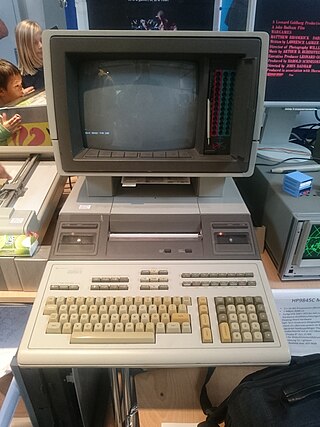
The HP 9845C from Hewlett-Packard was one of the first desktop computers to be equipped with a color display and light pen for design and illustration work. It was used to create the color war room graphics in the 1983 movie WarGames.

The PDP-8/e was a model of the PDP-8 line of minicomputers, designed by the Digital Equipment Corporation to be a general purpose computer that inexpensively met the needs of the average user while also being capable of modular expansion to meet the more specific needs of advanced user.
